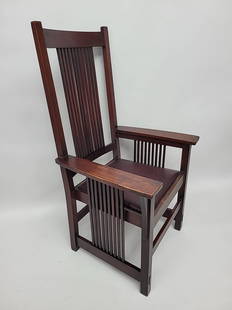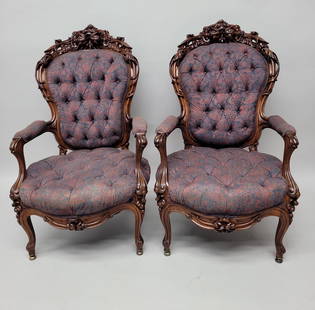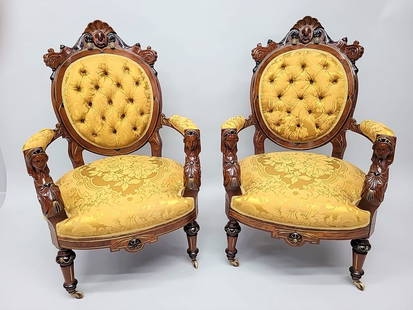
Pair of Federal Mahogany Shield-back Armchairs, probably New York, New York, c. 1790.
Similar Sale History
View More Items in Side ChairsRelated Side Chairs
More Items in Side Chairs
View MoreRecommended Chairs
View More




Item Details
Description
Pair of Federal Mahogany Shield-back Armchairs, probably New York, New York, c. 1790. Finely carved splats featuring Prince-of-Wales feathers below drapery swag centering an oval patera in ribbon frame, in bead-molded shield frame with high serpentine arched crest above conforming stiles, which are tenoned to shaped and relief-carved arm rests raised on outward scrolling concaved vertical supports, mounted to seat stretchers with curved brackets applied near the serpentine front rail, this raised on forelegs tapering sharply above spade feet, the slightly outswept and converging rear legs continuing from stiles through back seat rail, 60cm wide, 48cm deep, 96cm high (24 3/8in wide, 19 5/8in deep, 38 3/4in high). Seat ht. 17 in. Footnotes: Provenance The collection of Eric van Rooy. Kyser-Hollingsworth, Washington, DC, 6 December 2003. Literature Two poplar chair blocks are all that potentially survives of the original secondary woods. The chairs are identified as New York mainly for their formal and technical similarities among numerous published examples, most of which are made in New York, followed by Rhode Island, and Salem, Massachusetts. Among the New York characteristics of this set are evidence of medial brackets in the seat frame, the pronounced spade feet, and fine relief-carving on the armrests. The splat pattern is an attenuated shield framework centering a vertical plume of Prince-of-Wales feathers below swagged drapery and a fluted oval patera under the crest rail. This precise composition appears in shield-back chairs otherwise varied in their materials, use of carved or inlaid ornament, and especially the style of the front legs, which are more often outswept or tapered than raised on spade feet. Despite its clearly widespread popularity, the splat pattern does not appear in any known Neoclassical design sourcebooks, and the documentary evidence that does exist has only inspired a lively debate on the origins of shield-back chairs that feature it. John L. Scherer describes this arrangement of Prince-of-Wales feathers and drapery as one of three principal splat designs in early New York shield-back chairs; see New York Furniture: The Federal Period, 1788-1825 (Albany: New York State Museum, 1988), p. 13. Identification with New York was bolstered early on by the pattern's only known contemporary representation in a circa 1800 paper label engraved by Cornelius Tiebout for the New York City cabinetmaker Elbert Anderson. The label appears on a sideboard sold at Sotheby's, New York (28 June 1985), Lot 429, which once belonged to C.W. Lyon, the Manhattan dealer who also advertised a set of eight chairs descended in the Wanton family of Newport, Rhode Island, as 'obviously made by Elbert Anderson' in Antiques 59/3 (March 1951): 165. Charles Montgomery cautioned against this foregone conclusion in his discussion of two similar chairs at Winterthur (acc. no. 57.672.1, 2), which he still identifies as New York for having outswept or 'flaring' front legs; see American Furniture: The Federal Period (New York: Viking Press, 1966), cat. no. 53. In his essay on the tapered-leg armchair in the collection of George M. and Linda H. Kaufman (acc. no. 73.10), J. Michael Flanigan designates it as simply 'American,' emphasizing a relative lack of regional specificity in style, execution, and materials; see American Furniture from the Kaufman Collection (Washington, DC: National Gallery of Art, 1986), cat. no. 40. However, there is no such controversy in the more recent description by Wendy A. Cooper, who considers the armchair made in New York; see Masterpieces of American Furniture from the Kaufman Collection, 1700-1830, (Washington, DC: National Gallery of Art, 2013), cat. no. 4. Documentary evidence is even more compelling on four shield-back chairs descending from Admiral Stephen B. Luce (1827-1917) of Newport, Rhode Island, which bear the label of Newport cabinetmaker John Townsend (1782/3-1809). Two are in the Bayou Bend Collection, Museum of Fine Arts, Houston, Texas, (acc. no. B.66.11.1-.2); see David B. Warren, et. al., American Decorative Arts and Painting in the Bayou Bend Collection (Princeton: Princeton University Press, 1998), cat. no. F149; and Jennifer N. Johnson, 'The Chairmaking and Upholstery Trades of Colonial and Federal Rhode Island,' in Art & Industry in Early America: Rhode Island Furniture, 1650-1830 (New Haven: Yale University Press, 2016), p. 67-95. Another side chair is at Winterthur (acc. no. 66.112) and one is in a private collection, most recently sold in The Collection of Mr. and Mrs. Joseph K. Ott, Christie's, New York, (20 January 2012), Lot 156; see Rhode Island Furniture Archive, Yale University Art Gallery, no. RIF4262. The four are illustrated together in Morrison Heckscher, John Townsend: Newport Cabinetmaker (New York: Metropolitan Museum of Art, 2005), cat. no. 48, and p. 196-7. For further information on this lot please visit Bonhams.com For further information about this lot please visit the lot listing
Buyer's Premium
- 28%
Pair of Federal Mahogany Shield-back Armchairs, probably New York, New York, c. 1790.
Shipping & Pickup Options
Item located in Marlborough, MA, usPayment

















































































